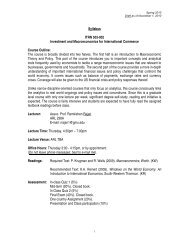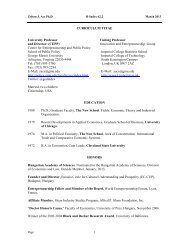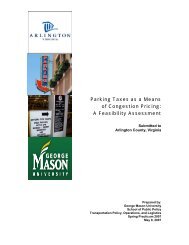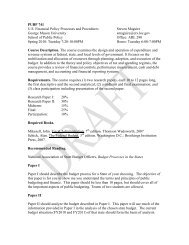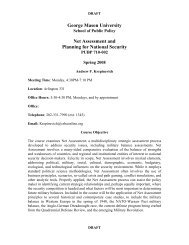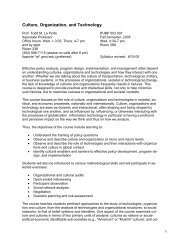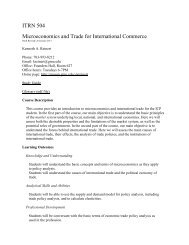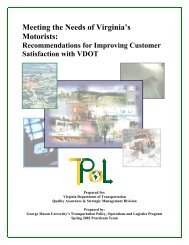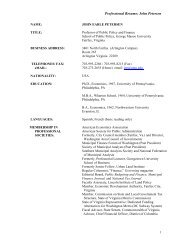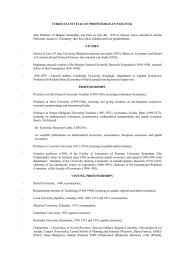Cost Benefit Analysis of Washington-Richmond High-Speed Rail
Cost Benefit Analysis of Washington-Richmond High-Speed Rail
Cost Benefit Analysis of Washington-Richmond High-Speed Rail
Create successful ePaper yourself
Turn your PDF publications into a flip-book with our unique Google optimized e-Paper software.
<strong>Cost</strong> <strong>Benefit</strong> <strong>Analysis</strong> <strong>of</strong> <strong>Washington</strong>-<strong>Richmond</strong> <strong>High</strong>-<strong>Speed</strong> <strong>Rail</strong> Spring 2010<br />
investor. Because these investments are a cost as well as a benefit, they are not a net benefit as in a<br />
cost-benefit analysis.<br />
There is <strong>of</strong>ten an element <strong>of</strong> benefit in these impacts. A worker who gets a higher paying job as a result<br />
<strong>of</strong> a transportation investment project benefits if he or she works just as hard as he or she did at his or<br />
her previous job but is paid more. Such projects produce benefits by increasing the productivity <strong>of</strong><br />
labor. A transportation investment project that increases the value and productivity <strong>of</strong> land and thus<br />
induces real estate investment can also provide a benefit, but the benefit must be measured net <strong>of</strong> the<br />
cost <strong>of</strong> making the real estate investment. Measuring these labor productivity effects requires a careful<br />
analysis <strong>of</strong> the local labor market and how that market is changed by the transportation investment.<br />
Similarly, measuring the effects <strong>of</strong> transportation projects on the productivity <strong>of</strong> land requires careful<br />
netting out <strong>of</strong> increases in land values that are compensated by costs <strong>of</strong> real estate investment and<br />
increases in land values that in effect capitalize other types <strong>of</strong> benefits that have already been counted,<br />
such as time savings.<br />
The benefits that should be reported for transportation projects include:<br />
26<br />
• Improved condition <strong>of</strong> existing transportation facilities and systems;<br />
• Long-term growth in employment, production, or other high-value economic activity;<br />
• Improved energy efficiency, reduced dependence on oil and reduced greenhouse gas emissions;<br />
• Reduced adverse impacts <strong>of</strong> transportation on the natural environment;<br />
• Reduced number, rate and consequences <strong>of</strong> surface transportation-related crashes, injuries and<br />
fatalities;<br />
• Any other benefits claimed in the project’s cost-benefit analysis.<br />
4.2 Affected Population<br />
Because these improvements are associated with improvements along a passenger rail line, the costbenefit<br />
analysis should clearly identify the population that the project will affect and measure the<br />
number <strong>of</strong> passengers affected by the project. Although the improvements being considered are<br />
directly related to passenger rail movements, the rail line being impacted has both passenger and<br />
freight movements that need to be addressed as part <strong>of</strong> the analysis. If possible, passenger and freight<br />
traffic should be measured in passenger-miles and freight ton-miles (and possibly value <strong>of</strong> freight).<br />
4.3 Discounting<br />
When preparing the cost-benefit analysis, the analysis should discount future benefits and costs to<br />
present values using a real discount rate <strong>of</strong> seven percent, following guidance provided by the Office <strong>of</strong><br />
Management and Budget (OMB) in Circulars A–4 and A–94 1819 .<br />
18 Circular A-4 (<strong>Washington</strong>, DC: Office <strong>of</strong> Management and Budget, September 17, 2003).<br />
19 Guidelines and Discount Rates for <strong>Benefit</strong>-<strong>Cost</strong> <strong>Analysis</strong> <strong>of</strong> Federal Programs (<strong>Washington</strong>, DC: Office <strong>of</strong><br />
Management and Budget).



